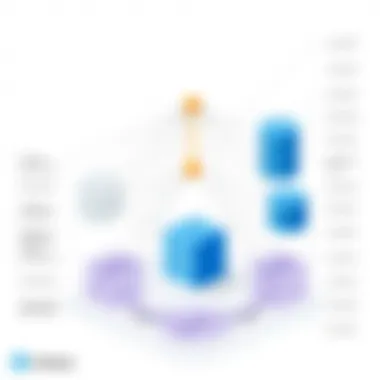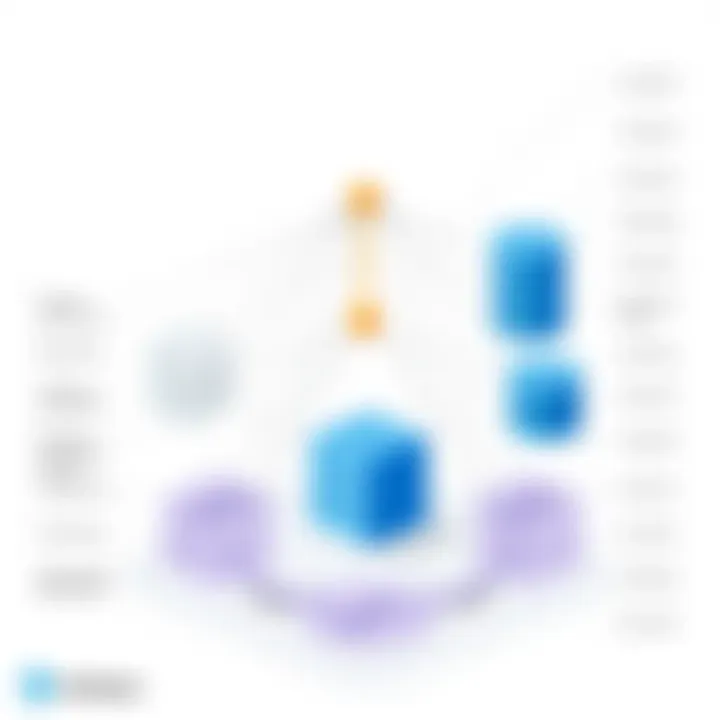Graph Databases vs Relational Databases: A Detailed Comparison


Intro
In the fast-evolving landscape of data management, the debate between graph databases and relational databases continues to ignite discussion among IT professionals and software architects. With a myriad of use cases emerging in modern applications, understanding the nuances and strengths of each database type has never been more critical. The choice between these technologies can significantly influence the performance, scalability, and overall architecture of software solutions.
Graph databases, characterized by their focus on relationships between data points, excel in scenarios requiring complex interconnections, enabling insights that are often difficult to glean from traditional relational systems. On the other hand, relational databases, with their tabular structure and decades of refinement, offer stability and familiarity, making them suitable for a wide range of transactional applications.
As we explore further, we will highlight key aspects such as their structural differences, use cases, strengths and weaknesses, performance metrics, and how these factors can guide decision-making processes for software professionals and businesses alike.
Prelude to Database Technologies
In the current landscape of technology, databases form the backbone of virtually every application that is data-driven. Whether it’s a startup trying to make waves in the market or a long-established corporation with vast troves of data, understanding database technology is paramount. This section serves as a gateway into exploring the various types of databases, specifically graph and relational databases, which are gaining prominence for different kinds of applications.
A well-chosen database not only optimizes data integrity but also enhances the speed and efficiency of operations. It’s not just a technical choice; it bears significant implications for user experience, scalability, and ultimately, the success of a business.
Defining Databases
Databases can be broadly seen as an organized collection of data, which facilitates easier access, management, and updating. Think of it as a digital filing cabinet where information is categorized for quick retrieval. Depending on the structure, databases can come in various forms: hierarchical, network, or the more common relational and graph varieties.
In relational databases, data is stored in tables with rows and columns, making it intuitive for users who have experience with spreadsheets. On the other hand, graph databases represent data as nodes, edges, and properties, capitalizing on the relationships between data points to provide insights that would be complex to derive from tables. A clear understanding of these definitions is crucial for decision-makers tasked with selecting the appropriate database technology for their applications.
Importance of Database Selection
Choosing the right database is analogous to selecting the foundation for a building; it must be sturdy to support the structure above it. A mismatch between application requirements and the chosen database can lead to inefficiencies and hinder performance.
When it comes to database selection, several factors come into play:
- Data Structure Complexity: Some applications require profound interconnections between data points that graph databases handle far more efficiently. Conversely, straightforward datasets might be better suited for relational databases.
- Scalability Needs: As businesses grow, so do their data needs. Understanding how each type of database scales in line with business growth becomes vital.
- Query Performance: Depending on the complexity of queries, one database might outperform another in fetching the required data swiftly.
"Selecting a database is not just a technical task; it’s about aligning with business strategy and future needs."
By grasping these considerations, organizations can make informed choices leading to optimized performance, better data management, and ultimately, enhanced business outcomes. As we delve deeper into this article, the distinctions and suitability of both relational and graph databases will become increasingly evident.
Understanding Relational Databases
Understanding relational databases is crucial when navigating the complex world of data management systems. As the backbone of many applications and services, these databases provide a structured way to manage and manipulate data effectively. Their importance lies in their ability to organize data in a manner that reflects real-world relationships, making it easier for software professionals to implement solutions tailored to specific requirements. This section will explore the core concepts of relational databases, how data is modeled within them, and the various systems that implement these models, offering insights essential for anyone involved in IT or business operations.
Core Concepts of Relational Databases
At the heart of relational databases is the concept of tables. Each table consists of rows and columns, where rows represent individual records, and columns define specific attributes of those records. This structure facilitates easy data retrieval and manipulation using Structured Query Language (SQL). Notably, the relational model emphasizes relationships between tables through primary and foreign keys, allowing for normalization—a process that reduces data redundancy and enhances data integrity.
Another critical concept is ACID compliance, which stands for Atomicity, Consistency, Isolation, and Durability. These properties ensure reliable transactions by maintaining data stability even during hardware failures or other unforeseen issues. Hence, when dealing with sensitive information, this aspect becomes particularly significant.
Benefits of Understanding Core Concepts
- Data Integrity: Maintaining accuracy and consistency across your datasets.
- Structured Management: Ensuring data is organized, easy to query, and maintainable over time.
- Scalability: Supporting growth as data needs expand without compromising performance.
Data Modeling in Relational Databases
Data modeling in relational databases involves defining the structure of data elements and their relationships. A common approach is using Entity-Relationship (ER) diagrams to visualize how entities interact within the database. For instance, a customer entity may link to an order entity, illustrating a one-to-many relationship—one customer can have multiple orders.
Normalization plays a pivotal role in data modeling, whereby tables are designed to minimize duplication. Each table serves a specific purpose, and joint queries retrieve related data efficiently. It's noteworthy that the first three normal forms (1NF, 2NF, 3NF) hold particular importance in achieving an optimized design.
"Normalization is a balancing act; you want to minimize redundancy while keeping your queries efficient."
Considerations in Data Modeling
- Relationships: Clearly define relationships to avoid confusion and ensure easy data retrieval.
- Redundancy: Regularly audit your design to prevent unnecessary duplication of data.
- Performance: Analyze and optimize queries to maintain speed during frequent data operations.
Common Relational Database Systems
There are several well-known relational database systems used in various industries. Some of the most widely adopted include:
- Oracle Database: A robust choice for large Enterprise Resource Planning systems, known for its scalability and reliability.
- MySQL: An open-source favorite, often employed in web applications due to its simplicity and performance.
- Microsoft SQL Server: A holistic solution favored for its integration with other Microsoft services and tools.
- PostgreSQL: Known for its advanced features like support for custom data types and robust transaction handling, making it appropriate for complex applications.
- SQLite: Lightweight and often utilized in mobile applications for easy data access.
Understanding the strengths and weaknesses of these systems can be the difference between a successful implementation and a data management disaster. Selecting the right relational database can empower businesses in managing their data more efficiently, leading to improved decision-making and operational effectiveness.
As newer technologies emerge and data landscapes evolve, a grasp of foundational database concepts remains indispensable for professionals in the field.


Exploring Graph Databases
Graph databases offer a distinct approach to data management, acting as a suitable alternative to traditional relational systems. Understanding how they work is crucial, especially as businesses grapple with growing amounts of data and complex relationships. Graph databases excel in scenarios where connections and relationships take center stage. This is particularly relevant in today’s world where the interconnectedness of data points can yield more insightful analytics.
Emphasizing on their significance, graph databases provide clear pathways to traverse vast networks of information. Their structure allows for dynamic querying and manipulation of interconnected data, often resulting in enhanced performance under specific use case scenarios. When professionals consider implementing a database system, grasping the essence of graph databases becomes pivotal.
Fundamental Features of Graph Databases
Graph databases are built on two core components: nodes and edges. Nodes represent entities such as people, products, or concepts, while edges signify the relationships among these nodes. This foundational architecture offers flexibility, making it easier to model complex systems. Unlike relational databases which depend on predefined schemas, graph databases allow for more organic and fluid data modeling.
- Schema-less Design: Graph databases often follow a schema-less model. This means that new kinds of relationships can be added without disrupting existing data structures. So, if you're integrating new insights, changes can be made on the fly and not locked away in rigid frameworks.
- Efficient Traversals: The relationships formed between data are treated as first-class citizens in graph databases. This benefits performance, particularly when analyzing deep connections. For instance, querying a network to find connections between various actors in a Hollywood movie database can be accomplished swiftly since each connection is explicitly defined.
In essence, the fundamental features of graph databases allow for a flexible and relationship-oriented approach that traditional relational databases often struggle to replicate.
Data Representation in Graph Databases
The representation of data in graph databases diverges from conventional methods. Rather than rows and tables, graph databases portray information in a visual and relational manner. Here’s how it typically works:
- Nodes: Each node encapsulates data values, similar to the attributes defined in a row within a relational table.
- Edges: These contain the relationship types, indicating how nodes connect with one another. This myriad of relationships showcases the intricate web of interactions.
- Properties: Both nodes and edges can have properties—key-value pairs that provide additional context. For example, a node representing a person can include properties like age, location, or even interests.
Due to this representation, visualizing data can be much more intuitive. For example, when examining social relationships within a network, one can easily map out the connections visually, which fosters a deeper understanding of the data at hand. The power of graph databases lies in their ability to represent data in a way that highlights connections rather than simple data points.
Popular Graph Database Technologies
When it comes to implementing graph databases, several technologies have emerged as frontrunners in the industry. Each offers unique strengths suitable for various applications:
- Neo4j: Frequently cited as the most popular graph database, Neo4j provides a robust framework with a rich set of features. Its native graph storage allows for efficient data traversal.
- Amazon Neptune: This fully-managed database service by Amazon Web Services supports both property graphs and RDF, making it ideal for companies already embedded in the AWS ecosystem.
- OrientDB: Blending the best of graph and document databases, OrientDB distinguishes itself by offering both agility in design and depth of analysis.
- ArangoDB: Another multi-model database, ArangoDB supports graph, document, and key/value data models, which allows for a versatile way to handle information.
These technologies provide various mechanisms to leverage graph-based data structures, catering to the needs of businesses that wish to maximize their data investment.
Graph databases shine where relationships matter, proving their worth like an intricate spider web that connects every aspect of real-world interactions.
Key Differences Between Graph and Relational Databases
Understanding the key differences between graph and relational databases is essential for anyone venturing into the realm of database technologies. This section sheds light on distinct structural, functional, and operational disparities that influence database selection for specific applications. Recognizing these differences helps IT professionals, software developers, and decision-makers determine the appropriate database model suited to their unique needs.
Structural Differences
Graph databases and relational databases have fundamentally different architectures that cater to varied types of data complexity and interrelationships. In relational databases, data is organized into tables consisting of rows and columns. Each table represents a different entity type while relationships are handled through foreign keys. This structure is good for uniform and structured data.
In contrast, graph databases utilize nodes, edges, and properties. Nodes represent entities, edges signify the relationships between them, and properties provide additional information linked directly to nodes and edges. This structural format excels in situations involving complex relationships and interconnected data, such as social networks or recommendation systems.
"A graph database shines where relationships dominate, whereas a relational database excels where strict schemas rule the roost."
The ramifications of these structural differences can be significant when it comes to querying and data retrieval. A graph database can efficiently traverse relationships with high performance, even with multiple connections, while relational databases may struggle as the number of joins increases.
Query Language Variations
Another vital differentiation lies in the query languages. Relational databases predominantly use SQL (Structured Query Language), which is highly standardized and widely understood among developers. SQL is effective for executing complex queries involving table joins and aggregating data. However, it can become cumbersome for traversing complex, highly connected datasets.
On the other hand, graph databases often utilize query languages like Cypher or Gremlin that are tailored for graph structures, making it easier to express relationships and access nodes efficiently. For instance, querying relationships in a graph database can feel more intuitive, allowing users to focus on the connections rather than the underlying data structure. This can be a game-changer in scenarios where flexibility and speed are paramount.
Data Integrity and Relationships
Data integrity represents another crucial area where these database types diverge. Relational databases excel in maintaining data consistency through strict schema definitions and ACID properties (Atomicity, Consistency, Isolation, Durability). These principles ensure that transactions are reliably processed, safeguarding against data corruption and loss.
In contrast, while graph databases can also ensure data integrity, they may relax some of the rigid constraints found in relational systems. Graph databases accommodate more dynamic and fluid data models, which can be beneficial for applications that require flexibility. However, this adaptability can sometimes lead to challenges in consistency, especially in highly interconnected environments.
Ultimately, when considering integrity and relationships, businesses must weigh the importance of defined structures against the need for flexibility based on their specific use cases.
For a more detailed understanding of database technologies, consider referencing sources such as Wikipedia or Britannica.
By informing yourself about these pivotal differences, you’ll be better equipped to make informed decisions that enhance the effectiveness of your software solutions.
Performance and Scalability Considerations
When choosing between graph databases and relational databases, performance and scalability are pivotal factors. Understanding how each database system handles transactions, scales with data growth, and measures performance can significantly inform your project's direction. This analysis aims to clarify these considerations, helping IT professionals and businesses make sound decisions aligned with their needs.


Transaction Processing Speed
Transaction processing speed is an essential aspect of database performance. Speed determines how swiftly a system can read, write, and update data. Relational databases, which organize data in tables, often require joining multiple tables for queries. This can slow down processing, especially as the complexity of data relationships increases. For instance, if you're building a retail application that must constantly fetch product data, join operations can delay responses.
On the other hand, graph databases are designed for rapid relationship queries and can effectively handle more complex transactions without the overhead of multiple joins. By utilizing nodes and edges to represent connections, they shine particularly in scenarios such as social networking platforms, where users and their connections can amount to significant processing demands. In environments that demand speed, such as real-time analytics for e-commerce, the advantage of graph databases becomes evident.
Scalability Challenges
Scalability is another critical factor. As data grows, how easily can a database expand to accommodate more information? Relational databases often face challenges with horizontal scaling; they are typically optimized for vertical scaling, which can lead to performance issues if limits are reached. Often, organizations must refactor their database architecture, incurring substantial costs and time.
Conversely, graph databases are built with scalability in mind, especially for querying vast amounts of interconnected data. They can typically scale horizontally, adding more servers to distribute the load effectively. However, this must be managed correctly. Deploying a distributed graph database can introduce its headaches, especially concerning consistency and synchronization across nodes. It’s a balancing act between optimizing speed and ensuring reliable data integrity in dynamic environments.
Performance Metrics Comparison
When comparing performance metrics, it’s essential to look beyond just speed. Factors such as latency, throughput, and resource consumption are also crucial.
- Latency: Relational databases can exhibit greater latency due to their complex query requirements, often leading to delayed responses. Graph databases, by contrast, generally provide lower latency for relationship-heavy queries, allowing for a more responsive user experience.
- Throughput: This refers to the number of transactions a system can handle in a given timeframe. Graph databases excel in environments with high volumes of real-time transactions, like fraud detection systems or recommendation engines.
- Resource Consumption: Relational databases may require more resources, especially when dealing with large datasets involving complex queries. Graph databases tend to be more efficient in using system resources as they can directly traverse connections without complicated joins.
In summary, evaluating performance and scalability is crucial when choosing between graph and relational databases. With their differing approaches to data handling, understanding the specific needs of your application will enable you to select the most effective system, ensuring the best balance of speed and efficiency.
"The choice of the right database should align with the unique challenges of your project, understanding performance metrics and scalability is critical for future-proofing your system." (Source: Wikipedia)
For further insights and readings, consider visiting Britannica, or getting community perspectives on Reddit.
Use Cases for Relational Databases
Relational databases have long been the backbone of data management for many organizations, thanks to their robust architecture and mature technologies. Understanding the specific use cases for these databases is critical, as it helps software professionals and decision-makers make informed choices aligned with their operational needs. In the sections that follow, we will delve into various applications of relational databases, highlighting why they remain prevalent and crucial in contemporary technology landscapes.
Traditional Applications
When it comes to traditional applications, relational databases find their sweet spot in systems that require a structured environment for data storage. Think of classic use cases like customer relationship management (CRM) systems or content management systems (CMS). These applications rely on a clear schema to define data types, relationships, and constraints.
For instance, in a retail scenario, customer records might include fields for names, addresses, and purchase history—everything neatly organized in tables. This setup not only aids in data retrieval but ensures data integrity through established relationships, such as foreign keys linking customers to their orders. In these cases, the efficiency of SQL queries becomes paramount.
Some other typical examples of traditional applications include:
- Inventory Management: Keeping track of stock levels, suppliers, and orders in a consistent framework.
- Manufacturing Systems: Adjusting production schedules based on inventories and demand forecasts ensures businesses run smoothly.
Enterprise Resource Planning Systems
Enterprise Resource Planning (ERP) systems represent a significant segment of relational database applications. These systems streamline all facets of business operations, including finance, HR, supply chain, and manufacturing. They rely heavily on relational databases to pull together data from various functions into a cohesive operational view.
Given the complexity and scale of ERP systems, the role of relational databases here cannot be understated. They enable organizations to manage resources effectively by providing essential insights through:
- Integrated Data Views: Multiple departments can access a unified view of essential business metrics without the lag associated with disparate systems.
- Accurate Reporting: Financial reporting benefits from the integrity and timeliness of data that relational databases provide, which is critical during audits or strategic decision-making.
Companies like SAP and Oracle utilize relational databases extensively within their ERP platforms, emphasizing their ongoing relevance in large-scale business management.
Financial Systems
Financial systems are another domain where relational databases excel. The structure and relational nature of these databases make them ideal for handling complex transactions and maintaining a high level of data accuracy.
In a financial context, consider a banking application. Such systems manage accounts, transactions, and customer records, where any deviation from accuracy can lead to substantial risk. Here, relational databases:
- Serve as a foundation for transaction integrity, ensuring that operations like withdrawals or deposits reflect the real-time state of customer accounts.
- Centralize reported data for compliance under regulations like Sarbanes-Oxley by maintaining comprehensive audit trails and regular reporting capabilities.
Furthermore, the ability to scale and manage large datasets effectively is crucial in financial applications due to the increase in clarity demanded by analytics and regulations. This reliance on data integrity and performance highlights why relational databases hold an edge even in innovative financial technologies.
“In the world of finance, precision in data handling is not just a luxury; it's a necessity.”
In summary, the persistent relevance of relational databases across traditional applications, ERP systems, and financial frameworks underscores their pivotal role in efficiently managing structured data. Recognizing this significance empowers organizations to harness the full potential of their data landscapes.
Use Cases for Graph Databases
In today’s rapidly evolving tech landscape, selecting the right type of database is crucial. Graph databases excel in scenarios that involve complex relationships and interactions among data points. Their structure is specifically designed to understand and represent these intricate connections. This section aims to showcase the significant use cases for graph databases, emphasizing where they shine compared to more traditional database systems.
Social Network Analysis


When it comes to social networks, the primary objective is to identify relationships and patterns among users. Graph databases, with their node-and-edge structure, are a perfect fit for modeling social interactions where individuals connect, share, and influence each other. This design allows for efficient querying of relationships, such as finding mutual friends, understanding the strength of connections, or analyzing community dynamics within a large network.
Consider Facebook. It utilizes a graph structure to address user connections. Every user is represented as a node, while their relationships, likes, and shares form the edges. This enables advanced features like friend suggestions and targeted advertisements, based on users’ interactions. Graph databases outperform relational databases in such scenarios, especially when dealing with large networks and the need for real-time analytics.
Recommendation Engines
Recommendation systems must analyze user preferences and relationships. Whether it's suggesting products on e-commerce platforms like Amazon or movies on Netflix, understanding user behavior is key. Graph databases help in storing detailed relationships between users and items, thus enabling superior recommendation accuracy.
For instance, take the Netflix recommendation system. It analyzes not only the movies you’ve watched but also the preferences of users who are similar to you—this is where graph databases bring their A-game. They track patterns within the network of users and their entertainment choices through graph traversal algorithms. This technique yields dynamic, personalized suggestions that evolve as more data is processed. As a result, businesses can drive better engagement and boost sales through tailored experiences.
Fraud Detection
In industries like finance and insurance, fraud detection is a pressing concern. Graph databases are adept at identifying suspicious patterns and detecting anomalies in transaction networks. Traditional relational databases struggle to represent and analyze such complex relationships efficiently, while graph databases can execute queries across multiple degrees of separation, uncovering hidden relationships that indicate fraudulent activities.
For example, in a banking scenario, a graph database can analyze transactions between various accounts to determine unusual patterns or connections among them. Suppose a user has an account linked to others that frequently transfer money at odd hours. The database can flag this activity as potentially fraudulent, allowing for swift intervention. By effectively leveraging the connections between entities, graph databases enhance the overall ability to safeguard against threats.
In summary, the versatility of graph databases in handling complex relationships makes them invaluable in areas such as social network analysis, recommendation engines, and fraud detection. Organizations aiming for an edge in these domains should seriously consider leveraging graph technology to capitalize on their unique strengths.
Trends in Database Technology
In the world of technology, databases are the backbone of data management systems. The landscape of database technologies is ever-evolving, influencing how organizations handle their data. Understanding current trends in database technology is essential for making informed decisions regarding the database systems to implement.
Trends in database technology shape both operational efficiency and innovation within various industries. As data becomes an increasingly integral part of business strategies, it is critical to recognize how these trends can enhance data utilization, improve performance, and adapt to diverse requirements. Here, we delve into key developments influencing the database environment today.
Emergence of Multi-Model Databases
Multi-model databases have recently gained traction as organizations seek flexible solutions that can handle different types of data structures. Unlike traditional databases that usually fall within distinct categories, multi-model databases allow for the integration of multiple data models— be it relational, graph, document, or key-value—into a single database system. This flexibility means businesses can adjust to varying data needs without overhauling their entire architecture.
For instance, consider a company that uses a relational database for transactional operations but also requires a document store for unstructured customer feedback. A multi-model database provides the versatility to manage both datasets cohesively without compromising performance or data integrity.
Benefits of multi-model databases include:
- Versatility: Support for multiple data types within a single platform.
- Streamlined Development: Reduces the complexity of managing separate systems for different data models.
- Cost Efficiency: Fewer systems to maintain leads to lower operational costs.
With the rise of applications needing to process various data formats, multi-model databases position organizations to be more agile and responsive in their strategies.
Impact of Big Data on Database Choices
The explosion of big data has dramatically changed the database landscape. As organizations collect vast quantities of data, the ability to efficiently store, process, and analyze this information becomes crucial. Consequently, the demands imposed by big data directly influence the choices that organizations make concerning database technologies.
Big data emphasizes the need for databases that can handle massive volumes of information at high speed. This has given rise to NoSQL databases, which often excel under such conditions due to their scalability and performance. It’s worth highlighting how traditional relational databases can struggle with big data due to their rigid schemas and the complex relationships between data points.
Organizations now consider the following:
- Scalability: Can the database grow with data needs?
- Performance: How quickly can large datasets be processed?
- Flexibility: Does the database allow for varied data types, from structured to unstructured?
The ongoing impact of big data pushes a growing number of businesses to evaluate and adopt alternatives to relational database systems, such as graph databases or multi-model databases, to optimize data management strategies.
"The future of database technology is leaning heavily toward flexibility and scalability, especially in the face of increasing data demands."
For further reading on this topic, you might explore articles on Wikipedia or check insights from Harvard Business Review regarding data trends.
Closure and Recommendations
In concluding this comprehensive analysis of graph databases and relational databases, it becomes clear that the choice between these two technologies is far from trivial. As we have explored, each database type offers unique strengths and limitations, and the importance of selecting the right one cannot be overstated. A misguided choice can lead to inefficiencies, increased costs, and ultimately hampered business growth. Thus, understanding the nuances of both systems is essential for IT professionals and decision-makers alike.
Graph databases are particularly adept at managing highly connected data, providing quick access to relationships among data points. They shine in scenarios requiring complex queries on interconnected structures, this is crucial in fields like social networking and recommendation systems, where data relationships are paramount. Conversely, relational databases excel in scenarios where structured data and transaction integrity are required. Their established practices in managing structured data can’t be underestimated, making them fit for applications like financial systems and enterprise resource planning.
The recommendations provided here should guide organizations as they consider their data storage strategies. Understanding specific business requirements, data complexity, and scalability needs will inform whether a graph or relational database is more suitable.
Summarizing Key Insights
Graph databases’ intrinsic design facilitates intricate relationship mapping, which is indispensable in specific use cases. On the other hand, relational databases are the go-to for traditional applications with clear structures and compliance needs. The distinction lies significantly in how they handle relationships and data integrity — those critical elements ultimately dictate their performance.
It’s important to emphasize that the evolving tech landscape may invite curiosity towards hybrid solutions. Multi-model databases present an option for businesses seeking flexibility, allowing integration of both graph and relational models. Organizations must stay alert to emerging trends as they shape database technology’s future.
Choosing the Right Database for Specific Needs
Selecting the right database isn’t merely a technical decision; it’s a strategy that can impact how an organization operates. For those with rapidly evolving datasets and complex relationships, graph databases represent a tailored solution. Apps that involve social interactions, fraud detection, and recommendation systems can leverage graph technology for enhanced user experiences.
Relational databases are more suited to organizations where data stability and comprehensive reporting are paramount. The case remains strong for legacy applications, transactional systems, and compliance-heavy industries. It’s all about balancing current needs with considerations for future data growth and evolution.
"In the realm of databases, one size does not fit all. Choose wisely, or risk stagnation."
For further reading and insights, explore resources like Wikipedia, Britannica, and relevant discussions on Reddit.







